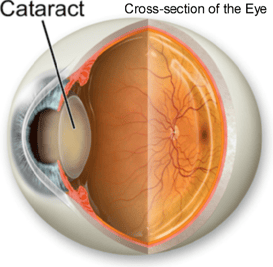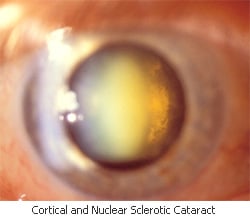 Cataracts & Cataract Surgery
Cataracts & Cataract Surgery
Cataracts Cause Blurred Vision and Glare Problems
A cataract is a clouding or opacity of the crystalline lens in the eye that decreases visual acuity and contrast sensitivity. The crystalline lens is a clear part of the eye that helps to focus light, or an image, on the retina. Most cataracts are related to aging. Cataracts are very common in older people. By age 70, most people have some level of cataract or have already had cataract surgery. A cataract can occur in either or both eyes. It cannot spread from one eye to the other.
clear part of the eye that helps to focus light, or an image, on the retina. Most cataracts are related to aging. Cataracts are very common in older people. By age 70, most people have some level of cataract or have already had cataract surgery. A cataract can occur in either or both eyes. It cannot spread from one eye to the other.
The risk of cataract increases as you get older. Other risk factors for cataract include:
- Certain diseases (for example, diabetes).
- Personal behavior (smoking, alcohol use).
- The environment (prolonged exposure to ultraviolet sunlight).
Age-related cataracts can develop in two ways:
1. Clumps of protein reduce the sharpness of the image reaching the retina.
The lens consists mostly of water and protein. When the protein clumps up, it clouds the lens and reduces the light that reaches the retina. The clouding may become severe enough to cause blurred vision. Most age-related cataracts develop from protein clumpings.
When a cataract is small, the cloudiness affects only a small part of the lens. You may not notice any changes in your vision. Cataracts tend to progress slowly, so vision gets worse gradually. Over time, the cloudy area in the lens may get larger, and the cataract may increase in size. Seeing may become more difficult. Your vision may get duller or blurrier.
2. The clear lens slowly changes to a yellowish/brownish color, adding a brownish tint to vision.
As the clear lens slowly colors with age, your vision gradually may acquire a brownish shade. At first, the amount of tinting may be small and may not cause a vision problem. Over time, increased tinting may make it more difficult to read and perform other routine activities. This gradual change in the amount of tinting does not affect the sharpness of the image transmitted to the retina.
If you have advanced lens discoloration, you may not be able to identify blues and purples. You may be wearing what you believe to be a pair of black socks, only to find out from friends that you are wearing purple socks.
Cataract Symptoms
The most common symptoms of a cataract are:
- Cloudy or blurry vision.
- Colors seem faded.
- Glare. Headlights, lamps, or sunlight may appear too bright. A halo may
 appear around lights.
appear around lights. - Poor night vision.
- Double vision or multiple images in one eye. (This symptom may clear as the cataract gets larger.)
- Frequent prescription changes in your eyeglasses or contact lenses.
These cataract symptoms also can be a sign of other eye problems. If you have any of these symptoms, check with our eye doctors at Master Eye Associates.
Many people mistakenly think they can see a cataract on their eye. That is usually not a cataract. A cataract is inside the eye, behind the pupil (black hole opening) and usually not visible to the naked eye unless it is very dense or white and opaque.
The symptoms of early cataract may be improved with new eyeglasses, brighter lighting, anti-glare sunglasses, or magnifying lenses. If these measures do not help, cataract surgery is the only effective treatment. Cataract surgery involves removing the cloudy lens and replacing it with an artificial lens. The newest technology for safer and more accurate cataract surgery is femtosecond Laser Cataract Surgery.
Cataracts are detected through a comprehensive eye exam that includes:
- Visual acuity test. This eye chart test measures how well you see at various distances.
- Dilated eye exam. Drops are placed in your eyes to widen, or dilate, the pupils. Your eye care professional uses a special magnifying lens to examine your retina and optic nerve for signs of damage and other eye problems. After the exam, your close-up vision may remain
blurred for several hours.
- Slit Lamp Biomicroscopy. The anterior eye and crystalline lens are evaluated in great detail under special illumination and very high magnification to detect a cataract or other opacity of the crystalline lens of the eye.
- Refraction. An eye test which determines the optical prescription or eyeglasses prescription to determine the best visual acuity to evaluate the level of blurred vision caused by a cataract. This test should be performed by an eye doctor (optometrist or ophthalmologist) for the greatest accuracy.
- Tonometry. An instrument measures the pressure inside the eye. Numbing drops may be applied to your eye for this test.
Your eye doctor may also do other tests to learn more about the structure and health of your eye.

 appear around lights.
appear around lights. blurred for several hours.
blurred for several hours.